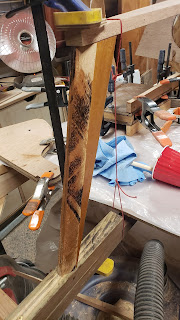As on many other small sailboats, assembling the Clancy starts with building the centerboard trunk. First, the inside faces of the trunk need to get sealed with epoxy. While you are at it, you can also seal up the rudder cheeks and spacer, and maybe even part of a centerboard trunk for a different project that you just have lying around.
It is also a good time to coat the interior faces of the bulkheads so you can sand them smooth before installing them in the boat. Anything to save a little bit of difficult sanding down the road!
Once the wood of the trunk (both the plywood sides and timber spacers), it can be assembled. Mix up a little thickened epoxy and spread it on the mating surfaces, and then clamp the whole assembly together. In a fit of epoxy-madness, I also glued up the cleats that attach to the daggerboard trunk at this time.
The New Yankee Workshop plans have two error with respect to the daggerboard trunk. The first is that they call out 1/2" plywood for the sides, when "Build a Clancy" uses 1/4". The second is the orientation of the cleat. The New Yankee plans call for the longer dimension of the cleats to be perpendicular to the trunk. Doing this causes them to significantly (and pointlessly) overhang the keelson and kingplank. If they are rotated 90 degrees (longer dimension against the side of the trunk), then the width of the trunk assembly is exactly the width of the keelson -- clearly what is intended.
Now things get exciting. The bulkheads are dropped into position on the jig. Ensure that the centerlines of the bulkheads are marked, and line them up with the edge of the crutch. Each bulkhead can be secured to the jig with a few temporary screws. I intend to bright finish my transom, so I secured it with a single temporary screw, driven in in a spot that will later be covered with the rudder gudgeons, and then further braced with with a few clamps.
 |
| Bulkheads in with keelson laying on top. |
Next up, the keelson is dropped in for a dry fit. The aft end of the keelson is cut with a bevel to match the transom. Once happy with the fit, you hold the keelson in place (lined up on centerline, flush with the bottom on the transom), and a pencil line on the underside of the keelson. Removing the keelson, you can line up the knee with this line. The plans call for the knee to be glued and screwed to the transom with bronze screws. The plans seem to call for an excessive number of screws throughout. Forgoing the screws, I buttered up the knee with thickened epoxy and held it in place with a clamp while it dried.
While the keelson is out of the boat, it is time to attach the stem to it. Thickened epoxy is applied to the base of the stem, and the stem is held in place on the keelson with leading edges and centerlines aligned. A single temporary screw driven through the keelson is sufficient to hold the assembly while it dries. (a permanent bronze screw could be used instead if you were in a hurry)
With a handsaw, the leading edge of the keelson is cut to match the tangle of the sides of the stem.
 |
| Cutting the keelson to the shape of the stem. You can see the temporary screw (driven through a sacrificial plywood pad) that holds the stem to the keelson, |
The keelson, stem attached, is then dropped back into the boat for a second dry fit. The aft end is secured to the knee with a temporary screw and then the forward end it bent down until the stem touched the jig. Temporarily holding the stem against the jig (ensuring the centerline of the stem is lined up with the centerline of the jig) with with a clamp, some string, or a pair of hands from a helper, drive a temporary screw at and angle through the aft end of the stem to secure it to the jig.
 |
| Dry fit with daggerboard trunk in place. |
Put the daggerboard trunk in place and hold it with a few clamps. Hot glue a pencil to the end of a long stick and stick it up through the underside of the trunk to trace the opening on the keelson. Remove the keelson again and cut out the opening to the daggerboard slot.
Now it is time to put it all together for good. I painted the mating surfaces on the knee, transom, and daggerboard trunk with honey-consistency thickened epoxy, and put a small bead of peanut butter-consistency epoxy where the keelson lands on the bulkheads. Drop the keelson back into place and re-affix it with your temporary screws at the transom and stem, and clamp the daggerboard trunk to the keelson and forward bulkhead. Before walking away to let things dry, measure between a number of different points to make sure the bulkheads are square to the keelson. |
| The backbone of the boat is all set up! |
 |
| Beveling the transom to match the angle of the keelson. A few more passes with the plane are required at this point. |







No comments:
Post a Comment